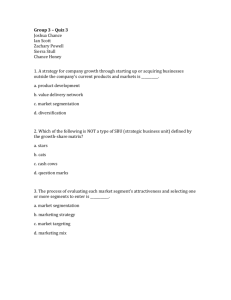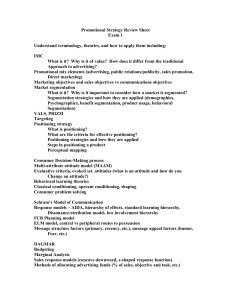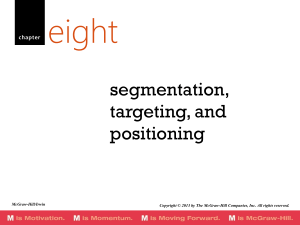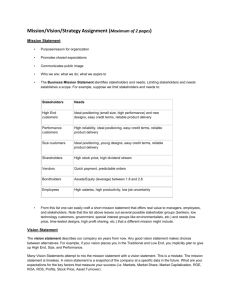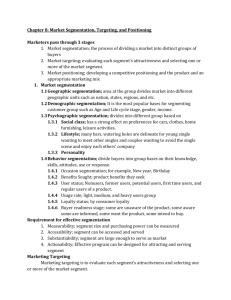Market Segmentation - Civil + Mineral Engineering
advertisement
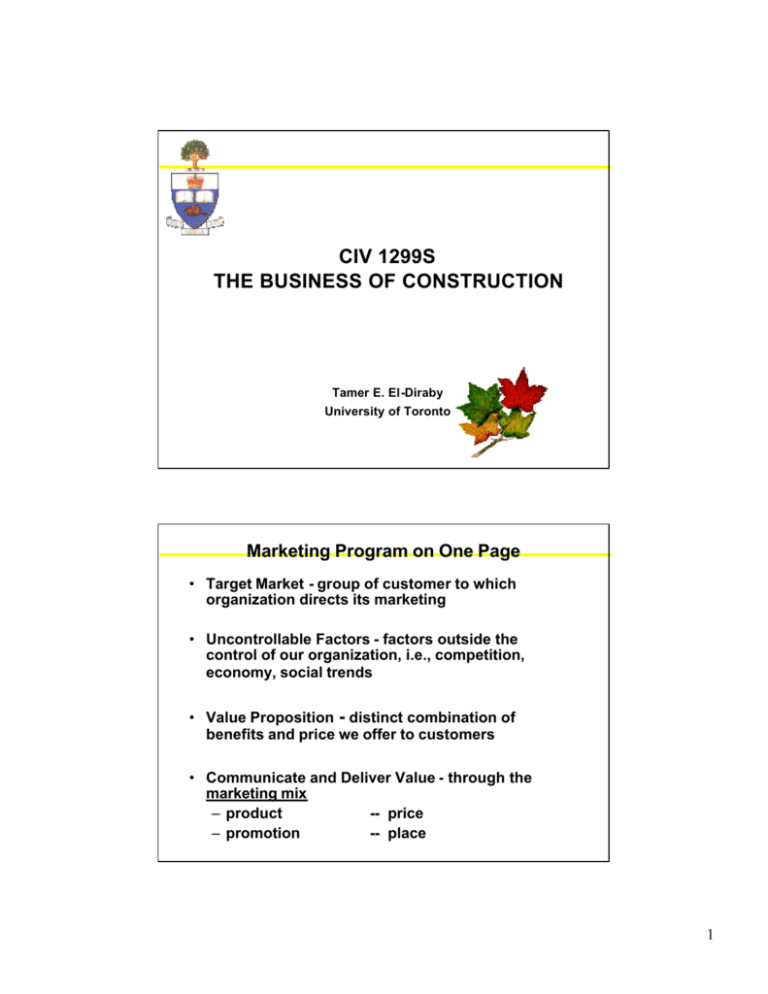
CIV 1299S THE BUSINESS OF CONSTRUCTION Tamer E. El-Diraby University of Toronto Marketing Program on One Page • Target Market - group of customer to which organization directs its marketing • Uncontrollable Factors - factors outside the control of our organization, i.e., competition, economy, social trends • Value Proposition - distinct combination of benefits and price we offer to customers • Communicate and Deliver Value - through the marketing mix – product -- price – promotion -- place 1 Marketing Defined Micro-marketing The performance of activities that seek to accomplish an organization’s objectives by anticipating customer needs and directing the flow of need-satisfying goods and services. Macro-marketing A social process that directs an economy’s flow of goods and services to effectively match supply and demand and to meet society’s objectives. Marketing Overview • Applies to profit and nonprofit organizations. • NOT just persuading customers to buy. • Begins with customer needs and focuses on customer satisfaction. • Marketing activities --but it is a philosophy that guides the whole business. • Seeks to builds a relationship with the customer. 2 Industrial Evolution F F R&D M P Q F Q P M I R& D Q R& D P The Competitive Edge Quality Product Process People + Info Now-then Us-them Customer + Marketing = Profit Who Where How 3 Important Note • Marketing in Manufacturing Industry • Marketing in Service Industry • Marketing in Construction? The 4-M Approach to Advertising • Who is your Market? • What Message do you want to convey to the Market? • What Media will you use to convey the Message to the Market? • How will you Measure the effects of the Message delivered by the Media to the Market? 4 The Three C’s • Customer • Competitors • Company Customers • Who buys and why? è wants vs. needs • How many customers are there; will there be? • Are there relevant (segments)? 5 Competitor Analysis • Who is the competition? How is this determined? • Why analyze your competition’s strengths and weaknesses? – Because consumers have choices • Once the competition has been identified, ask what are their … – Objectives? – Strategies? – Strengths and Weaknesses? How do You Want to Compete? • Market Leadership – McDonalds, Microsoft, Nestle, Dell, Schwab, Sony • Market Follower (including Fast Follower) – Wendy’s, Gateway, Lite Beers • Market Challenger – Virgin Air, Panasonic, Sprint, Avis, Pepsi • Market Nicher – Logitech, Victoria’s Secret, The Body Shop, Palm Pilot 6 Company Analysis • Why analyze your own strengths and weaknesses? – To view the competition through the eyes of your customers – To assess your relative ability to win over the customer • Corporate and Business unit Objectives • Strengths and Weaknesses Strengths and Weaknesses Checklist Performance MAJOR STRENGTH Marketing 1. Company reputation -------2. Market share -------3. Customer satisfaction -------4. Customer retention -------5. Product quality -------6. Service quality -------7. Pricing effectiveness -------8. Distribution effectiveness -------9. Promotion effectiveness -------10. Sales force effectiveness -------11. Innovation effectiveness -------12. Geographical coverage -------Finance 13. Cost/availability of capital -------14. Cash flow -------15. Financial stability -------Manufacturing 16. Facilities -------17. Economies of scale -------18. Capacity -------19. Able, dedicated workforce -------20. Ability to produce on time -------21. Technical manufacturing skill -------Organization 22. Visionary,capable leadership-------23. Dedicated employees -------24. Entrepreneurial orientation -------25. Flexible or responsive -------- Importance MINOR STRENGTH NEUTRAL MINOR WEAKNESS MAJOR WEAKNESS ------------------------------------------------------------------------------------- ------------------------------------------------------------------------------------------------- ------------------------------------------------------------------------------------- ------------------------------------------------------------------------------------- ---------------------- ------------------------- ------------------------- ----------------------------------------- ----------------------------------------- ----------------------------------------- HI MED LOW ------------------------------------- ------------------------------------------------- -------------------------------------- ---------------------- ---------- ------------- ---------- ------------------------------------------- ------------------------------------ ---------------- --------------------- ---------------- --------- --------- -------- ---- ----- ---- --------------------------------- --------------------------------- ----------------------------- ------------- ----------------- ------------- 7 Bringing the 3 C’s Together: Situation Analysis • What customer needs and wants can we meet? • Do we want to meet them? – What is the payoff – size, growth, share, profit potential? • Why us? Why not someone else? – What advantages/disadvantages do we have/face? – What competitive responses will our strategies provoke? • What steps do we need to take to achieve our goals? • How sustainable is our business/marketing model? The Four P’s Product Place C Price Promotion 8 Product “Customers don’t buy 1/4” drills, they buy 1/4” holes.” A product is a set of benefits from which customers derive value A product is not a set of… -features (tangible things) -performances (things that it does) What about services? Construction Products 9 Price • The issues – What is the value to customers of the benefits the product provides? – How much does it cost to deliver these benefits? – How much do or will customers have to pay to get these same or substitute benefits elsewhere (i.e., from competitors)? • The objective – Choose price to maximize long-run profit Promotion (decisions) v What is the objective? v Awareness v Persuasion v Reminder u What is the appropriate message? v What is the appropriate vehicle(s)? 10 Place (distribution) Managing the Marketing Process Consumer Segmentation Product Price Competition Company Target Position Promotion Place 11 The Marketing Mix: The Four P’s Product Place Promotion Price Physical Goods Service Features Quality Level Accessories Installation Instructions Warranty Product Lines Packaging Branding Objectives Channel Type Market Exposure Kinds of Middleman Kinds and Locations of Stores How to Handle Transporting and Storing Service Levels Recruiting Middlemen Managing Channels Objectives Blend Salespeople Kind Number Selection Training Motivation Advertising Targets Kinds of Ads Media Type Copy Thrust Who Prepares? Sales Promotion Publicity Objectives Flexibility Level over PLC Geographic Terms Discounts Allowances Hierarchy of Objectives Company Objectives Production Objectives Finance Objectives Product Objectives Marketing Objectives Place Objectives Personal Selling Objectives HR Objectives Promotion Objectives Mass Selling Objectives R&D Objectives Price Objectives Sales Promotion Objectives 12 Marketing Overview Market Analysis Marketing Strategy Marketing Tactics Customer Competition Company Probing Partitioning Prioritizing Positioning Product Place (distribution) Price Promotion Mark*Strat: Analyze 3Cs - Determine Strategy - Execute Tactics Marketing Planning Narrowing down to focused strategy with screening criteria Customers Company S. W. O. T. Segmentation & Targeting Product Place Target Market Differentiation & Positioning Price Promo Competitors External Market Environment 13 Defining The Market Selecting target marketing approach Segmenting into possible target markets Narrowing down to specific product-market All customer needs One broad product market Some generic needs Homogeneous (narrow) product markets Single target market approach Multiple target market approach Combined target market approach Matching Products to Markets Generic Market Definitions Customer (user) needs + Customer types + Geographic area + Product type (good and/or service) ProductMarket Definitions 14 Marketing Management Market Research Studies Questions and Answers New Information Information Sources Internal Data Sources Marketing Models Decision Maker Results Answers ? Inputs Decision Support System (DSS) Databases External Data Sources Marketing Manager Decisions Outcomes Information Technology Specialists Feedback Elements of Marketing Program Target Market + Marketing Mix = Marketing Strategy + Time-Related Details = Marketing Plan + Other Marketing Plans = A Firm’s Marketing Program 15 Steps in Segmentation Market Segmentation Product/Service Positioning Market Targeting 1. Identify Segmentation Variables and Segment the Market 3. Evaluate the Attractiveness of each Segment 5. Identify Possible Positioning Concepts for each Target Segment 4. Select the Target Segment(s). 2. Develop Profiles of Resulting Segments 6. Select, Develop and Signal the Chosen Positioning Concept Portfolio Analysis: The BCG Matrix STARS Invest ??? Problem Child Reinvest Ca sh Flo w Growth & Cash Required High > 10% No Invest Low <10% Divest CASH COW Cash Flow DOG 10 1 0 Relative Market Share wrt Biggest Competitor logarithmic scale 16 The BCG Growth-Share Matrix HIGH LOW STARS * Market Leaders * Fast Growing * Require Investment to Grow STRATEGY * Protect Share * Reinvest earnings through price cuts, Product Improvement, More Efficiency * Obtain Large Share of New Users HIGH Market Growth CASH COWS * Profitable Products * Generate More Cash Than Needed For Share Maintenance * Slow Sales Growth STRATEGY * Maintain Market Dominance * Invest in Process Technology Improvement and Price Leadership, R&D in Other Product Markets LOW PROBLEM CHILDREN * Rapid Growth * Poor Profit Margins * Enormous Demand for Cash STRATEGY * Invest to Aggressively build share * Buy existing shares by acquiring DOGS * Majority of Products fall in this category * Cost disadvantage - few growth opportunities at Reasonable Cost * Markets not Growing STRATEGY * Focus on a specialized, defendable segment * Harvest: Cut back all support to maintenance * Divest (sell); Abandon (Delete from line) Market Attractiveness The G.E. Multifactor Portfolio Model High Business Position GROW BUILD Medium REINFORCE SUPPORT Low Market Attractiveness S MAINTAIN HARVEST High Medium DIVEST Low Market Attractiveness * Market Size * Growth Rate * Cyclicality, Seasonality * Competitive Intensity * Rate of Technological Change * Barriers to Entry * Economies of Scale * Regulatory Environment Business Position * Market Share * Product Quality * Price Competitiveness * Brand Image * Production Strength * Financial Resources * Technological Skills * Sales Effectiveness * Distribution Capability 17 Methodology Select market segments Select pool of experts Develop evaluation criteria Develop matrix Analysis & conclusions Case Study: Egypt • Egyptian economy: 2nd largest in ME • GDP = $94 billion • GDP growth rate: from 1.9 to 5% • Inflation: from 21 to 7% • Privatization / BOT • Changes to business laws 18 Market Segments • Electric power (E) • Sanitary works (S) • Water supply (W) • Civil works (C) • Residential buildings (R) • Non-residential buildings (N) Companies • Five major companies (A, B, C, D, & E) • More than 75% of the market • Control almost every large project • Largest employers in the filed 19 Market Attractiveness CRITERIA WEIGHT Overall market size Annual market growth rate 20% Historical profit margins 5% Barriers to entry & exit Competitive intensity Resource & energy require. 10% 15% Environmental impact 10% 20% 20% Company Competitiveness CRITERIA WEIGHT Market share Market share growth rate 10% Product quality 15% Productive capacity Unit cost Material suppliers 20% 15% Managerial efficiency 15% 15% 10% 20 Company A 5 High S 3.67 Medium E C N W R 2.33 Low 1 5 3.67 Strong 1 2.33 Medium Weak Company B 5 High S 3.67 Medium N E C W R 2.33 Low 1 5 3.67 Strong 2.33 Medium 1 Weak 21 Company C 5 High S 3.67 E C Medium W N R 2.33 Low 1 5 3.67 Strong 1 2.33 Medium Weak Company D 5 High S E 3.67 C Medium N R W 2.33 Low 1 5 3.67 Strong 2.33 Medium 1 Weak 22 Company E 5 High S E 3.67 C Medium N W R 2.33 Low 1 5 3.67 Strong 2.33 Medium 1 Weak Analysis • More research is required in the area. • Sanitary& power projects are the most attractive segments. • Building projects are the least attractive. • One major company leads the market in almost every segment. 23 Positioning • Now that we have segmented the market and picked out the segments we want to target with our offering, the next question is, how can we convince consumers in the target segment to choose our offering? • To do this, we have to convince this segment that our product / service / firm: • Meets (or exceeds) their needs • Does it better than competitive offerings • This is the role of Positioning in a firm’s marketing strategy Needs • Value = Performance Quality ÷ Price • Performance Quality = f (Product Attributes / Features) • That is, consumers are more focused on the Benefits from the product, or Perceived Quality Perceived Price could be different from the actual price of the product (e.g., costs associated with delayed production) • • Value = Perceived Quality ÷ Perceived Price = Benefits ÷ Perceived Price 24 Suspension Turning Radius Example Sportiness Engine Capacity Wheelbase Roominess Quality Headroom Miles / Gallon Economy Maintenance Attributes Benefits Perceptions ABCs of Positioning • Attributes. Understand the attributes of the product or service that drive the consumers’ perceived product or service ….. • Benefits. The next step is to differentiate your product or service offering from those of your competitors’ via your …. • Communication of Value. You can change your advertising message, your channels of distribution, your brand name, etc... 25 Finding the Attributes • • • • • • • • • • • • • How does consumer become aware if need for your product / service? How does consumer find your offering? How does consumer make final selection? How does consumer order and purchase your product or service? How is your product / service delivered? How is your product installed? How is your product service paid for? How is your product stored? What is the customer really using the product for? What does customer need help with while using the product? What about returns and exchanges? How is product repaired or serviced? What happens when product is disposed of and no longer in use? Positioning Analysis 1. The key to positioning is determining the needs of consumers along (several ?) important benefit dimensions 2. Consumers perceptions of the existing services / products / firms in the market (including yours ?) along each of these dimensions 3. Inferring opportunities / threats from the way in which consumers perceive the set of products (in 2.) relative to their needs (in 1.) • • • A perceptual map typically focuses on the two most important attributes or benefits that consumers seek. The perceptual map contains consumers’ Ideal Points (i.e., their needs from 1. above) along each of the dimensions It also contains Brand Locations, i.e., consumers’ perceptions of the brands in the market along the two dimensions of interest 26 A Perceptual Map Sportiness Porsche BMW Acura NSX 1 Jaguar 4 Supra VW Golf Economy Miata Prelude Celica 2 6 5 3 Corolla Civic Volvo V70 Twingo Punto 1~6: Clusters of Ideal Points Radius proportional to # of consumers Questions to ask when Positioning • What position do we own? • Find the answer in the marketplace • What position do we want? • Select one that does not become obsolete • Who must we out-gun? • Do we have enough money? • Spend enough to accomplish objective • Can we stick it out? • Expect internal pressures for change • Do ads match our position? • Don’t let creativity get in the way 27 Summary • Segmentation is the concept that recognizes diversity in the marketplace. The process of segmenting the market produces clusters of people who are similar • Targeting a segment involves the identification of segments to which marketing effort will be directed. Marketers must select targets for which their product will meet a need. • Positioning requires designing a company and product image and developing a marketing mix to promote the image to the target segment(s) Long-Term Strategies Product A Product B Sales Sales Dollars Total cost 0 Total cost 1 2 3 Years 4 5 0 1 2 3 4 5 Years 28

